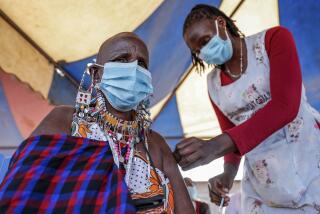AIDS Growth Slowing Worldwide, U.N. Finds
- Share via
The rapid growth in global AIDS cases that characterized the first quarter-century of the epidemic is slowing as some regions of the world are showing evidence of bringing the disease under control, according to a UNAIDS report issued Tuesday.
“The epidemic seems to be slowing down,” said Dr. Paul De Lay, director of evaluation for UNAIDS, also known as the Joint United Nations Program on HIV/AIDS. “The incidence is increasing, but not at the past rate.”
India, meanwhile, has surged ahead of South Africa to become the country with the most people living with the AIDS virus -- 5.7 million infections compared with South Africa’s 5.5 million.
The total number of HIV cases reached an estimated 38.6 million last year, according to the report. About 4.1 million people became infected with the virus in 2005, and 2.8 million died. Those numbers were lower than comparable figures for 2004, but UNAIDS attributed the difference to more accurate reporting rather than a decline in rates.
De Lay said the ongoing gains resulted from “a massive scale-up of prevention and treatment.”
Prevention programs have proved particularly effective in Uganda, Kenya, Zimbabwe, Burkina Faso and Haiti, noted Karen Stanecki of UNAIDS, who coordinated data compilation for the 630-page report.
HIV prevalence -- the proportion of the population infected -- has dropped by more than a quarter in those areas among young people ages 15 to 24. She attributed the declines to increased condom use, less casual sex and a delay in the beginning of sexual activity.
“This is the first time we have really seen that outside of Uganda,” said Dr. Mark R. Dybul, the acting U.S. global AIDS coordinator. “There has been a dramatic partner reduction among young people.”
Treatment of AIDS victims in low- and middle-income families has increased significantly as a result of the U.N.’s “3 by 5” program to treat 3 million people by the end of 2005. Although the program didn’t reach its goal, the number of people receiving antiretroviral drugs increased to nearly 1.5 million, compared with 240,000 in 2001.
One demographic area in which treatment has failed is pregnant women, according to the report. Mother-to-child transmission of HIV can be blocked with a relatively cheap drug regimen, and UNAIDS had hoped to reach 80% of all HIV-positive pregnant women with the 3-by-5 program.
Instead, only about 9% of these pregnant women are receiving the drugs. Stanecki attributed the low rate, at least in part, to the stigma associated with the disease.
“A young woman who appears healthy and is pregnant simply does not want to reveal her condition to her family,” she said.
Sub-Saharan Africa, with about 24.5 million HIV-positive people, remains the focus of the AIDS pandemic, but concern is growing in regard to Asia.
About 8.3 million people in Asia are HIV-positive, two-thirds of them in India. About 80% of the cases in that country result from unprotected heterosexual contact, but the outbreak is fueled by intravenous drug use in the country’s northeast, the report says.
But, given India’s large population -- 1.1 billion, compared with South Africa’s 44 million -- the country’s HIV prevalence rate is still low, Stanecki noted.
And some progress is being made in India, according to the report. In four of the country’s 28 states, the infection rate among young pregnant women declined from 1.7% to 1.1% between 2000 and 2004.
The report was issued on the eve of a three-day U.N. conference on AIDS in New York beginning today. It comes days before the 25th anniversary of the discovery of AIDS, which is Monday.
More to Read
Sign up for Essential California
The most important California stories and recommendations in your inbox every morning.
You may occasionally receive promotional content from the Los Angeles Times.










